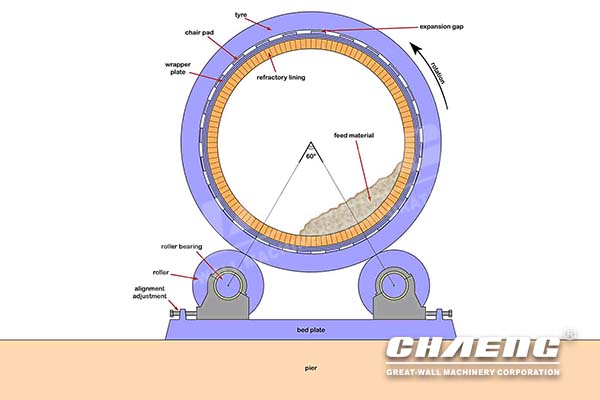07 Jul,2022 UTC+8 Views:
The rotary kiln supporting roller is a very important component in the rotary kiln equipment. It is generally made of cast steel. Since the supporting roller bears part of the weight of the rotary kiln, it can ensure the normal operation of the equipment. The operator should always pay attention to the quality and operation of the supporting roller, especially when replacing the kiln supporting roller, he must pay attention to the replacement process

Roller replacement process
1. Prepare the maintenance plan, master the key dimensions and accuracy requirements, and make technical preparations; transport the auxiliary equipment to the maintenance site and prepare the tools
2. Clean up the debris on site, find out the center line of the rotary kiln and the supporting roller, and make a mark on the supporting roller base and the base plate;
3. After the rotary kiln is cooled, place the jack stably in the lower middle of the wheel belt, and place a wooden board on the top of the jack to prevent it from slipping, and tighten the jack at the same time;
4. Remove the heat shield of the roller tile, the roller tile cover, the oil spoon, the circulating water pipe, etc., and put them in a place out of the way;
5. Jack up the pulley and make it about 10 mm away from the supporting roller. Check whether the jack has leakage and sinking. If there is, remove the fault first. If there is no sinking, place a steel plate between the two sides of the jack cylinder and the tire. Or the special square iron is tightened to prevent leakage and the sinking of the wheel belt, and the pressure relief inspection of the jack is carried out;
6. Make a mark around the base of the supporting roller, loosen the anchor bolts of the supporting roller base to be replaced, push the supporting roller to a position where it is convenient for lifting with an inverted chain or a jack, hang a wire rope on the supporting roller, and hoist the supporting roller away. on site;
7. Clean the supporting roller, measure the diameter and wear of the supporting roller and shaft head; clean the supporting roller shoe and determine whether it is still in use, if not, remove it.
8. Clean the foreign body oil stains on the new roller, measure the size, and open the tile mouth according to the inspection and test results to ensure that the side clearance of the tile mouth is about 2/1000 of the shaft diameter, and the oil guide wedge groove is excessively natural; Make its wrap angle at about 60 degrees, touch the scar, and make the left and right spacing not more than 3 mm. The thrust plate is tightly combined and the scar is even;
9. Grind the tile and the tile so that the contact scar is less than 5 mm between left and right. Then fix it on the tile tire;
10. According to the measurement size of the supporting roller, calculate the position of the new supporting roller, and draw the position of the tile seat after replacement to ensure that the force state of the supporting roller is basically unchanged from that of the old supporting roller; lift the new supporting roller and place it on the tile. positive, then remove the sling;
11. Use an inverted chain or a jack with the jacking wire to put the tile seat in place and align it, and recheck the coincidence with the new position. After there is no problem, tighten the anchor bolts and tighten the jacking wire;
12. Set the wheel belt a little, remove the square iron, and slowly put the wheel belt on the supporting roller; clean the shaft, the tile, install the oil spoon, connect the circulating water, and carry out the experiment, if there is no water leakage, fasten the tile cover; Add lubricating oil and install heat shield;
13. Slowly rotate the rotary kiln, and check and judge the contact between the thrust plate, the bush and the shaft according to the oil film condition. Check whether the oil spoon interferes, the clearance between the thrust plate and the tile skirt, etc.; the inspection and acceptance are normal, the tools are cleaned up, the site is cleaned, and the replacement of the supporting roller is over.